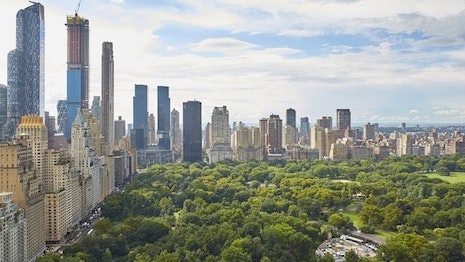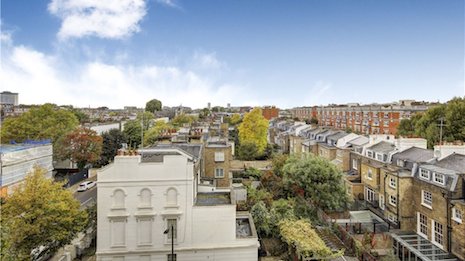Millennials and Gen Xers are growing their investments in luxury real estate in London, but data from Knight Frank finds baby boomers outspent them in 2018.
Boomers bought a total 8.58 billion pounds, or $10.9 billion, worth of property in London last year, compared to about 3.5 billion pounds for each of the two younger generations. While younger consumers are gaining spending power, boomers remain the generation with the greatest financial assets, allowing them to invest in pricier homes.
“It is no surprise that baby boomers spent the largest sum on property investment in London in 2018,” said Liam Bailey, global head of research at Knight Frank, London. “However, what will be interesting to see is how the gap between millennials, Generation X and baby boomers reduces over the coming years as the opportunity for wealth creation amongst younger generations becomes more and more prevalent.”
Luxury living
Boomers tend to choose traditionally posh locales in London, with Kensington their top choice, according to Knight Frank’s Wealth Report.
Among millennials and Gen X buyers, Islington is number one by volume of sales. Showing a generational divide, Gen X’s second choice is Kensington, while Gen Y next prefers the Tower Bridge area.
Across all three generations, Marylebone is popular, placing second for boomers and third for the younger cohorts.
The report also found that in London and across the pond in New York, real estate pricing is impacted by the proximity to parks.
New Yorkers who live within about 500 feet of Central Park see a 29 percent premium on their properties. Meanwhile, Londoners positioned the same distance from Regent’s Park and Hyde Park see respective 29 percent and 18 percent boosts on their homes’ values.

Proximity to Central Park boosts property costs. Image credit: Redfin
There has been a lot of new development at the southern end of Central Park in recent years, with costly condominiums coming onto the market.
The luxury towers sprouting along West 57th Street in New York have earned the awe of luxury consumers and the ire of local residents.
Developers are placating rancor by saying that the towers are too thin to cast bothersome shadows on Central Park and that the ensuing business generated by the occupants will outweigh grievances. Meanwhile, critics argue that Central Park's identity as a haven for residents of all economic backgrounds should be not sullied to attract global travelers (see story).
Other brands have also looked to Central Park proximity as a perk.
For instance, hospitality brand Mandarin Oriental is investing in residential spaces in one of the priciest cities in the world, as hotels move further into residences.
The luxury hotel group has announced it will be managing 69 high-end residences under its name on New York's Fifth Avenue. The hospitality group is touting the impressive Central Park views as a selling point of the building (see story).
Top markets
London and New York are prime luxury property markets, but they have fallen behind Hong Kong in Knight Frank’s rankings of the costliest cities for residential real estate.
Hong Kong sales average $4,251 per square foot, compared to $3,022 for second place London and $2,989 for New York, which came in third.
While its real estate is the priciest, Hong Kong’s most expensive sale ever occurred in 2016, with a home sold for $28,154 per square foot.
In most of the top 10 prime cities, including Dubai, the difference between the top sale and the average is about 200 percent. Singapore and Paris have less of a difference in their sales, which Knight Frank attributes to their more moderate prices.
Luxury real estate prices around the world are growing at their slowest rate in almost a decade, despite the rise of global wealth.
Knight Frank’s Prime Global Cities Index for the first quarter of 2019 showed that prime price growth has dropped to 1.3 percent, down from 4.3 percent two years ago. Since the first quarter of 2009, luxury real estate prices have climbed an average of 57.4 percent (see story).
Even with the slowing growth, real estate is still seeing blockbuster sales.
“Back in 2011, I made a somewhat controversial prediction that the top of the prime London residential market would see sales reach 10,000 pounds per square foot within a decade,” Mr. Bailey said. “A single sale in 2017 at well above 11,000 per square foot justified my optimism.
“The impetus behind my exuberant forecast was research from The Wealth Report,” he said. “Year-on-year, it was becoming increasingly clear just how much the growth of globalized wealth was shaping global property markets and propelling demand for the very best assets at new levels."
{"ct":"TCSPfSCEARob+U87KpFQuuuNsHhuiGGwgtQE4S0KwuKZfB7DRBZjQLIb65HASaFSC4sjI6rc5qY2kr\/7hGku68yniXr4ENSi01\/Y7IeteCXRSLmcukcvXRHc\/COaViy+3VMrmmXSCO+RhHkftTiC5gifB9svcOBqgFc\/xzvrY2PW96xi5crtQqEh4fhfuk67qDYT6+9nse\/ouSmvzGxKAlou2JNpsDQd+H2Q+HRaCSWfQ\/eBvYIHBFl56N+YOVS+FSBikYKbG5COj2DOSuiflgVa6W2\/PN5NYNqEkCAW0tyQpJGuIQ\/+G\/BZ0xCCZLb+Cw6dPyzVUMDwX+ZFyLkIYnsHiYIMQiRjmyf9ZCUFJuh7\/jF7sb0VVIr8d4JMLxfaMUiGGTqGlEsw7wcxI9txGrxa0qhceXLxSichNQ4ZmHC57eA5ekwkUIhYXHEP\/u0qnL\/3T35Och8d3UaLufaWGOBkSbK3omG4JLXbwFfCYnn\/sIvmCZgalAVfnhm7EV8FAwXhJny3rHvqzvWMIoz6\/+1FpdrqLg4b\/Vyt2enoMElGp4qWOT73JoP55o9U\/Slv99DNEEv9hBCDHzissBx0HliQkKbhKQxBQkUWzlcLKxwCOvzFI2D\/f4ZuZ5qsXRNijcXRrhWN1q\/F1Zwy7eMhwH0ucuF2S7V676UbfsLE6LZe9+OeSnrz628GBFWKMvY1Y9yYnpFAruE3hIzYCbuiMW+u4wr5BWzXYQmDOs0waUp3pUziCodtCjLleWQC3qzIMA+UwY0dd88TkusyYWXAxUje1mU+ROhembSP622pzQoYeNcbuwdKmMDPFSAavf6bkjoUZnogKx8cXLdA8QkjqcfuUlAXLbAOGnUl94H69Ze729zL0OTc4xuPaVHCaka\/Rj7+EghiQslpzsU5nJXVgJo57Tu9TounlLuDyX2PvbpK+hqpHMskidHR+7EkAdOt6cePk\/GqXKyNMPHppDKxWe5pwyXNaKo3d+K4Tw7GrVwMIWIC8kivtCdBtkOgwAwdKa\/\/bIdWc0X42zDpNFVqnqP47TiJ5xYcDA6aAAYGOV4jLbE1322J5wT2sc5tPdszDeJ3K3pSpSp8RLQNL4S+gsw1byccz7bnQEGSMu6nWPzzh8JU1fT2II9gjHvPzzL6wXDCCOAxa+RrXQqp3ouIuxlYNVuWOGEZ5Qaa04rVVyAqcq1nnneuwHPpI17uQU1EiCayBdCbINC1V+ZyiHxSkcpidjWTpnloq6EXipGwp\/N+mL23GePa7d45gw+TND9UfL6b9PQ\/AxEavQXLrt\/RHatv\/yc0MpoMhAvjzmxbwagfD\/6yqgt0xp7m7H16XrHB3EZ+SVi+dy4Oq7EcIu3a3AurLNWaT92cnkYLBfChK49S2WHICvzFQXFhottcRZhlXDE88lbk6VCWGXdv0ajQFNqbvy0qIPbzjPThjBqZ6SbT+U+7HxBR76+gsvJlg8eI4JTkTIX\/xQ2ES1BPhTQRTmUcYwQcZrhVuyyQ9nYY1BfhZ5d37x9QouiqpoMB2gjOy5rKMdNO2w4Oav9EE+8T1zVmD19AtGC63GHyK+\/S+ViVL0VN0Cefr1DLnafZhMzvpPLLCPWFTxsTFImQI6mtznkWqy4ATe9ypfEkh2F7YZ8+jlAIjSB5lxQfwsX1lXuzNk4OV8rOzplQwXCfAH1XA4Il92naLFoXFUltMJjb80gmwP+vRWqUbVVhXaEs9wbG3jRd6No6jYcHHQtOVI4oVIkVqXE3Amh8nwwM0lt1zPkMyIBMiVBdF1mWGWwW\/hQyuguubKU+E4jMAj6PzM2Gsx\/\/wCRVhUeKyNSIcNR2MKeLh78Ua0eN5NhZnd4SjDL1kNxkOoOgD4b3ciTqKllaI3HnUZsmu2rxfXRvHB\/Ys8yYDfklUpItXrwi7U46Ct3A3BGXudrg+\/21TPrXr6engbYzHFs1KPJ1am5cxRwzE\/unyVjGnKrDimYH2N+OMPPDGNAyRU+GZwJVlX7SWdhfojazEpKQzdMZ8p5XpOfGpxVzNVjq2aldzG1VJbbffh6VORL8X01lqjdDm+bO0dDp7eHnGSbw0++oSWpnD+Sf2xNzJDDdnUw8oWedAYQHt3pvNirhLg\/Y6K7X\/BGjyPxYHV97ZtxbZsdgInz9yMXShFOQe2Q9nfObT2oBtiM\/D3RS3WYpNbA51IjSkDCE+H+rDJhvft6EKILkzKnxS9e1WZHNk5iQ1hvKJeb+nG9UL4fijHEBqYad1teLXzVqv8noHUyZUe28HB85hNtmb4AgHVxxF2HemY\/mtBQhNB1PIjaFCCib5+H2nuOvn3IZZddWK6Mw02VY\/wuUtaJRiYmYiqvWJGnzIgfmwxSwTP1T1z8Ct3kNh4a5Srtu4U49JV8MwChSYVFTw6wM9\/RHaPZkLjADcGBB8RmfpMLWvISUuGnD6NPbtaFJ9JXgE4uOI0OQttZ2DUAZC0vROOhIupd6w2LLuLnaJ1KFVxgUjJ0t4KyK7citeSzBa9cKw3pX4LlN83HUTaoyKRn3RGZg41NWsPSnt9KT2bHU+MWJR2o9v2AlHeDgJ9yiVeH2HKiCn6QHzk1c50uuMrZHj9TTR3Ycl4c1zg5p1EyNaT0ycmIDMFf6Z\/t8lO9oBg7A0NGxwTXNd477ujriEKQnWHbPIMAu1y3tCOm03tkXp8+CAM3ksga\/khK8ldfbw\/59CF2ivAhAjfqjX1PjnMAJzQ4G2t73PNaGuGZlesbIiJVrDV6FoV4GrSPU8uahf4FRcake2edVEM2bGw5cl+tTV0oiwwU4gOakNKmXrsB2NsiJew3W1949iLdUscg\/yPso+rlr52V3tx77nCTstRCxUy0w99fGLg4YimB6WNCMRKGA2cEx912s3DIrp6LForvsakV5H528lp6pAvI9TI5d3WiQwzBLPTe2XQZA3xw5w6oN5LPXSG1ZgmcLQwVNdx\/+PaLyzaRatdPyK9sAmt5nFp1r0jHRbpMUiG7Wst5UMIN\/tusF4CzwEEEaZMuOqOT6TwKl5RVABq7wfFJEz\/l9BiZbzrltCtvGvo32NjBUetxqTBozCD0skS9g5PREqBtuUlHNstMS\/rV8ygCfIJdIDiEedo8JpDbz70uI9HiSRL5sXQQrFFvQtdUcV\/JPuH3Q9wTYIM3ueNHkYLt+3IV8ByYezbvuWyABvTnAUciPMRoDP1bJyf4cMshRVomJeB8Wh0Eky\/AT8E\/furvcP+hiMYZmPwsma74\/9wHRi9Qsqt5pxaEpwXMHUE4Nc4rciWT61lkCYbY5QTupnyiDrZiOY8L5PxSXkP6hYnZFSBFRL06XpaCzH3cATLRQgcpwgWmdEQRch77zA3WM2Aiy7qs7BaXHoR2pHWkAlF6\/Kw6JrGKuotOoF\/WvR4KPqMIX7+0EBM97MjHywI3IWxDrWzAgi3+lW0DZXfHIV3I4bns8+aoqwrfMKifVZrLdYyAFsNzc2TE0cd1We+rnC+kfF4z89Pqgu\/qRIsb+3mP1rEznkSfYP8SjNBkcV7QDkEVcOr86gG6pirBVk\/mwUltV25q8J9wrxVKC6UrGqDAu+4urLzAIcPX2ewjhyhTEBLhpB9mtHGDbpxtcHpHZJgImOYX71iKPuhiEEQFgwL7tx5MtvzMnFjJUb+BW1fQGn8l0pGbhUdZDRPVhDTRvuwbkKSr9k74Oq3JEOX3c\/kAm1zn+\/nOwq5dY5DRmofTij2d3mqXC7juhjmgxHxZz0LxE6DJq4qE+0g6atqFROCVN4sdmXpFOJrSRlKKwElIWZeVrxypt7\/ZxXS3C3YHtHK2NI5BF\/lhR82LqjThmDnSGr7CZpaCks7CLPtYJeXQH7eQYkAPwtZ2n1QqX1nGopkA5mX9SQgS0D+rXRxhseUR6iffdArP7EP8HOdeiii5PT9UuZu8bP6tOEr\/rx2hHWacQHFMaWQC73P+yNvniMmmzji\/U9O9m3FgGUC5JCc0Sn5z3nv7uxpkHHORC25DBqsTHXuOVMRfAuE4\/98edVcVTpXUV+URXJpxhzazo\/yvHLVntmVyu+7d8QH+w01GOEpvKz0othxSQXKf7q+1\/351bTNdDRCTRe1mUZJaa\/r7Yj\/BDCJp8OnwMYAwlsENulKhiNR\/PUIO4yv8eogB5CDxg72t5I0t8usPSMlHdVgy98pE6zA\/+opsg1DW6tqYV3DszQyZeO8ucNcYwhb0eArpNTZTtC5a4SY5w00Gx21DYh9EB+WDNt0RDLtFeiCSsxwF7nYkiMQaGEepWT+WRXGKluyCjSJJNfGUKkzY9RYNNoJW27inxXrrDH0nKrgUTpbbYYsqEZaMX+iMhNeRrB8UwUFSwu1zGYfiFAZQCffxYHA13+1SF\/lDxquzRCA\/t9MgfGQgWSzgcFoBZAMszJpp+l\/0kC9\/CL6u4gH\/sxgV5gSN0NHbyk4PRjkmbSiYGpka2turge1IvoiQtJYXg3ikmHTgIypWMojbsNXtl7TLMNOXzt7ap60uvDb+Tu13\/6EMjmr0qJliRxl+danUc40OiUAwkeosPxoLFDDI\/\/amyEy8teHYQ5mV9NHzVnYHoE8nuQJ0d6Au0hucYx7mt0mugoYmyrKHdhJLHYyaoQeKx9BlNFE5IolCLHQn+wm0zzyWVOBYm7ASbxhP+FZsQV802LlUavHwWElQBs8bonj5NfaeDWkianWgfBm5cvjofITSecQ4muzNepya8dU8+0mg2IwM9fXfOUzlxNphMGgrY7AjmvRF+ZThadhqTcDXNk2490j08M5I7LWspmh9BG+TbeCMFunZH5Yh5FxRKuya1Ubp7GplAQjVEs7\/TmDe7guR3xbJFK7WB7NwDPA2YhrV7SEZGdrWdmxaGW8nrQ+fTDiGN\/VO7\/N0\/YN9\/pIJ5cGXgLkg6XDF9d2hkdCfW1LRIWtsKiolDcLiTFPeYeyfWHrMWn80TVvVTUStObd37Zcoa1QD0mr\/JjU1vFe9NeqrfLOz++\/y1eQb2Js8rzcda2QomyMddF1Zke7Hb16ONBpSTJ5b2gnj4Cfr5p08PT1XcVb4QRNqQci9rD10mxHK5HiTypIEmyWX\/QKstaETuzjaG9jGTqcAMR45sDTlnI8AHZIP\/V9ya5DagJQ9vxmSgDDeoT5WqjtbP3zzPy7JOYDlX\/0uc+OCxyJskR+xrhEJ654Bybp3HH4SvEncW+Uwn27izIlCpAMQMROl6HVKRv4BR3G2VMU1qykif5rKu65zkRD4YWek0cQ22AF9XsHKSFiegE2LDV6nM8w+NpLUdMaCe1XcUUpCxmPiEPFskdVlTQndTL7vKW152iRy0UoP29SL6c1QfmAXwr8WN2BpjxiqPycezk6JWjQOPfcFYVKT22MfhH4VjMwOzSZhUXCSVrVHY4X0voDWmVCMqGBxT6QEt6vfnXVI6kNbWD52C5LkkxP8GTKMflRKoX\/z5vawJg52B2sGFk2z1GN4qh4Ifg4hh9KZxEUFyUjw5yIUVVV7iaR8r9LGx3aHU3ouPUjXTEni941AKg2COjGVgEavi7gW0vs\/D\/aKOzchVLA3MUaovncUsJgVXB1CwSEK5gC3zd90gCsS0Gfh4uVOZ6IWCxMNnyJd3NIgA8BItLFgd3Pr9+LF4IEDbjXZWrrM70a0We93sr38Z+FsafcsHUpYfSc5wiUPsT\/55phZNobQqlWiuQZHKEo227u43xlKK+D8XBBaKoi2pQDuPJWeTDqWCNYUyKVR96bl1z77+b111gqrFJGQ8LfId2F1s5pJljDR5tr0PvGycVKC63dLaSjc+qWjYRivNbGizHfSDguHN3sbJCCyPFRLZ3uwMmZ6oDuXjSTgLgUbgzz2BAhUwsGZQRYwKp2dWfv4wPanj7\/25cM6r0tEDnQfIV10nMwwdkiacMwU+jEucFyGTkXACzvIvRHUC2SMM4Yp7fiN0PVFzNuMLgN98LjiJColCO8ZpJcFqEsgrQud1HwsoWf4YgUs3+\/3xKZxv8oav4XkJi6zMRf1KL+bZOrTWE7bHHWnCRnBEpaACCArtRA9cZJB2exYa9Urk2eX8tSgE6dP\/k0OaNKdI9XR\/FOzISNzJn+VXHtP3VMy\/dlHHYlt+GL5hku5q3+\/I4WzofV+CGvYFVRHRs1htf2kmHdP5l\/snPa7OD9d6nLY3RY961EmTmVu+cwv+JX8IupnGkFfsrloUo3nux1ZHHC+jEtRuKPSf3BjrmMiPTpEm2EHlOrh8ge4xm4uac+4uMsGERo4jAb9Omvsq7Gv+GgOr9evHtaMzivAd36KbN676St6DM5AAire5IaScBlB2gGZ33hkmKksgZ01JSlzht37RiLjMF0odNVHB2yiZr9sbsWpWKooQaA4PnQ4ookX\/sTVWpsSPF6FbdGz361sSGw4eKNH4IQ9la4vFNnSalWMFZe8DeTwQGylyBwk24gFUSBDH+86Nf8uTZdKcdX7a0VKCzOdk0fLEa39dxyyKIgBdjlB\/mhB1\/tif4A3By91CJkA0mG\/DEtujYcCCkAEYUMeYMZIuH2VFdrdVCqSJcHU\/RFuZkvm01K25QS7SWqMFc\/jZJz5KL+1REG5NA7BjJH2atRpTVUTSkmg6sMvVPirhkj\/MC5w0cM2SFkeIvZIhbdOzrIyCkG+vOEO5QcdK+n0BWwUvhYuhhnYqIluSGux2C+R1Fn\/OYJYNnNsUYULPl\/ztBGx7eCRrFuqv\/Upp7fHDpgupdOV7cDSoB7YlCjk\/TjasC5RJdKj+08\/JHxlI0PpC8iLQNgC\/PbkH\/93pykeqVWxTiNbo6KnFcwmT0s8mizDpZjl2TFJkkxpY6nDKWvapE4RIqc4757jyUJlkI+Gkz7CQ2fWFYMpclwcM+h\/H5FjDyEpYH7SLz0YvT5ptpvT7KOI746PBsgGWIhHOkoHlV7OEEUG1JZ9MHixpqlUsiNkwWSJsGDEzhsl5tLkw0Q1vjCgK7mdSU34+ejQPeUtQdf4gZbbscYvTn\/XTIMQZzQxe0rHhZCqSPQ7ZFU6qZDs+VikmVBv8AoJPsnwcK9cpSPRbwI0Xwxrk1OuEmRSheoO\/E8l+UkBVV6CYwa1pMPtber+E7MpoHJkdiiCpCCo8Nk9d3vzVslzKW46rpl7MPu3NFixCPnDz78yunJTLH7+M3lCJSLLNt2X93P95cfJXVZGgfWWaogub3uXDfUhSJRw5fxx9ut9\/TGjQeu76ezML8MiimJ+LUCKSta0zQi2zJA7kEV55z+vytAVFyAdI\/8r7K2ZTg1ETNp6Zy4GSK2i3v889jwwcRTsv6bxSfs7Uw3vtHv99TnY5Z3ZdcwCS6jpSoGNEYvWChmimVuF0XK61WF2hA7Nbxu0DZ6a0Eqsz1oqhr+rMLry7hfoVfG3Suqmx78BnQvO2ndUXNLoXglHH0uNLHDLS7CJbhmhfQvYcDU9IBN7kVmPW6H+rpcYi2A\/SSmek0RyaiUDKNR4gPrexBNH2zB+MZciJB2Scs0lWvMq2lPajDNYqIa4c2ciUvcAMWEKua7x7wzZv6B\/sR9fc65sp+cVX1LHz0yY5y458P0N8rxnigQCtkkVYzhrnh0JJBOmTmiVRpiL3\/K+RpeIdEU+1njy6v1UMpOo4mk\/YYAuf3NCIVqSzboqJjf8idRrOa7Ew+dXdK+jvEgI8J4hhHsMrkqoja7hMr1ZyBiaBpFhbGy8JU71djR9khWi8mDhNy9xNR957E2lXlvzaSnr8iy0m4vpnETqvWGIaLS1mx1yN9byyUUpDRLCMO\/iEEswiihXIj4z6Xnetrwcswbl08euPKdAA\/O52yG\/YNd5fVLAPNC10rWTHSsfmMleABsCiIcooIxI1e4hUwEFtycLNpXWgXqFwpF1xAsd2bFW3kDhT\/+zqHTxrgTKvMdK\/Hgy5yvgvEHd5tsp\/yv2ojSbGj7a+fEX7+MAfBm9\/JkAIaK3JeRz52waqMfB7vk83vJRbg2i1qgLm\/qlZ8D6FiGsc3lg2Dcc4EAIvaC8qLIhi4abHA2v1KPcsxqIWdyayuQkA4v4DmbJhjKi4xS7UMdCfErl2LuTamdm4aLktHNGpwbuhI881YMnARIO+bT1gweSiUfOre64XAS4K0sfcc7TTFzAV8S8kGVHjrl60shBxNbLG2GJROI211Ty6hQpBMKM+N2LMz8Io1odt3GqcpogCEeg42c3JwRaMpFMFpfM0PRzdFSvbTemPZflfFYo6J86CBu6n2idBIrnhyeRdyiu65mF1LrQCgtIRYHV5T0wHorXyr3CNdQZ5","iv":"bd7c0286961d22a253c41d9fe9339bee","s":"8653e45a3466c835"}

 London's Kensington neighborhood. Image credit: Knight Frank
London's Kensington neighborhood. Image credit: Knight Frank